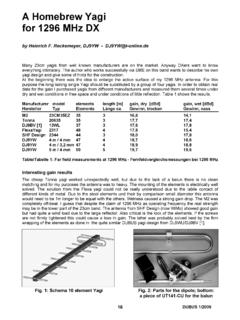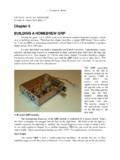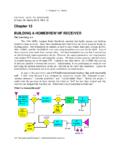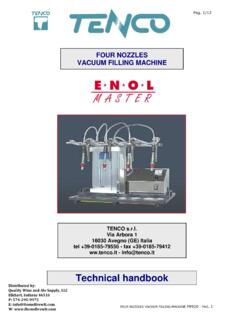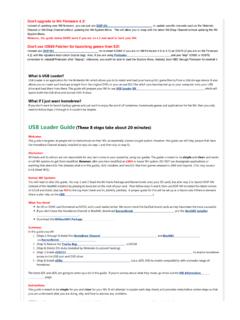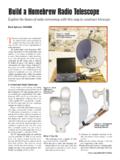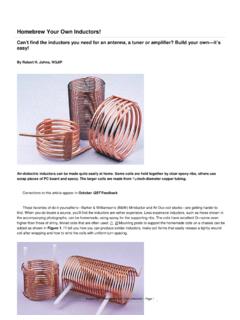Transcription of BREWING WATER - The Homebrew Club of Silicon Valley
1 BREWING WATER Mike Conant Nov 1, 2013 MIKE CONANT Background: Homebrewer since 1994 Penchant for big, hop-forward IPAs, well before they became a west coast phenomenon Now into curiously flavorful farmhouse ales! 11/1/2013 2 BREWING WATER Introduction: Why as a brewer, do you care about WATER ? Treating WATER for Chlorine and Chloramine WATER pH, Alkalinity, and Hardness Managing WATER flavor profile Acidifying your sparge WATER 11/1/2013 3 INTRODUCTION Why as a brewer, you care about WATER ? 11/1/2013 4 WHY DO WE CARE ABOUT WATER ? It is 90% of your beer Typical WATER sources contains chemicals that impact the beer process and beer flavor Knowing how to handle WATER will improve your beer 11/1/2013 5 WHEN YOU CARE ABOUT WATER (AND WHEN YOU DON T) Most WATER sources are good to brew with and make good beer!
2 BREWING GREAT beer requires management of your WATER , especially when: Your WATER is nasty (too much iron, salt, or other off-flavors, or too much chloramine / chlorine) Full mash BREWING alkalinity/pH or calcium deficiency impacts to mash effectiveness When WATER mineralization doesn t meet the style When not to care about WATER Extract BREWING just know what flavors your WATER may be adding You brew what you brew, and it works Talk about ions reminds you of the horrors of high school chemistry class 11/1/2013 6 THREE REASONS TO MANAGE YOUR BREWING WATER To remove unwanted chemicals or flavors in the WATER To Manage the chemistry of your mash To Tailor your desired flavor profile 11/1/2013 7 TREATING WATER FOR CHLORAMINE AND CHLORINE 11/1/2013 8 WATER RULE #1: REMOVE CHLORINE AND CHLORAMINE FROM BREWING WATER Chlorine (as hypochlorous acid)* and Chloramine are results of public WATER supply treatment Chlorine and chloramine react with phenols to make chlorophenols which have a very low flavor threshold and can give your beer that medicinal or band-aid flavor Filtering with activated carbon, boiling, or just letting the WATER sit overnight will remove chlorine Chloramine is stubborn and cannot be boiled off.
3 Quality granulated activated carbon (GAC) filters can work if you manage flow rate Recommendation: Use Metabisulfite (aka Campden Tablets) to remove chloramines (and chlorine) from WATER because it is cheap and easy. 11/1/2013 9 *Chlorine in this form (HClO) is bleach -- a disinfecting oxidizing agent -- and acts differently than the Cloride (Cl-) ion contributed by salts, a topic covered later METABISULFITE EASILY CLEARS CHLORINE AND CHLORAMINE FROM WATER Potassium metabisulfite or sodium metabisulfite effectively removes chloramine Takes just a couple of minutes! Campden tablets are a convenient form of metabisulfite Use 1/4 g, or 1/2 Campden tablet, per 10 gal Potassium Metabisulfite, sold in bulk powder ($4/lb), will last you forever (Metabisulfite comes in handy for wine must and cider making, but that is a different topic!)
4 11/1/2013 10 Metabisulfite additions are a *small* amount of chemical and will not affect taste or mineral profile. Additions listed treat up to 3ppm chloramine More details than you ll ever need: WATER PH, HARDNESS, AND ALKALINITY 11/1/2013 11 WHY YOU CARE ABOUT PH pH measures a solution s acidic or basic nature (1 acidic 14 basic) Acids (Latin acidus/ac re, means sour) RO/ Distilled WATER pH is Municipal WATER has a pH of 8 WATER companies want it slightly basic You care about pH when mashing Target pH between and ~ for dark beers ~ for tart, crisp beers You care about pH when sparging Sparge WATER should be < pH to prevent tannin extraction pH in mash impacted by the grain bill and WATER alkalinity pH is typically adjusted by adjusting grain bill, salt buffers, and/or acids 11/1/2013 Source.
5 12 WATER HARDNESS Hardness is due to the concentration of calcium (and magnesium) in WATER Temporary Hardness: Calcium or Magnesium paired with Carbonate/Bicarbonate It can be boiled off (bi/carbonate leaves as CO2, calcium stays behind Permanent hardness Calcium or Magnesium paired with Sulfates or Chlorides Cannot be boiled off 11/1/2013 Classification hardness in mg/L hardness in mmol/L hardness in dGH/ dH hardness in gpg Soft 0 60 0 Moderately hard 61 120 Hard 121 180 Very hard 181 13 CARBONATE (CO32-) AND BICARBONATE (HCO3-) These ions prevent decrease of pH (act as a buffer) They are twice as effective in raising wort pH as calcium is in lowering pH. Contribute to alkalinity Manage through pH adjustment Carbonate and bicarbonate are in balance, based on the pH 11/1/2013 14 WATER ALKALINITY Alkalinity Is generally due to Carbonate / Bicarbonate in WATER * Acts as a buffer to pH changes (absorbs acids without changing pH much) Excessive alkalinity can make our mash pH too high, unless mashing with dark grains We can lower by boiling, adding dark grains, adding acidulated malt, or adding acids Too little alkalinity: will not work for dark beer mashes (Toasted malts make your pH lower, too low with low alkalinity WATER Alkalinity can be raised with adding Pickling Lime, Potassium Hydroxide, or Sodium Bicarbonate (see table) 11/1/2013 *Ground WATER Alkalinity is set equal to.))
6 AT = [HCO3 ]T + 2[CO3 2]T + [B(OH)4 ]T + [OH ]T + 2[PO4 3]T + [HPO4 2]T + [SiO(OH)3 ]T [H+]sws [HSO4 ] 15 RESIDUAL ALKALINITY 11/1/2013 16 Residual alkalinity is the measure of alkalinity left after the acidity of the malt reacts with the WATER s hardness Helps predict mash pH based on WATER profile and beer color Not very accurate Recommendation: use the WATER calculator and buy a pH meter! WATER RULE #2: BUY A PH METER Chemistry calculations, including Residual Alkalinity is great for understanding and predicting mash pH In practice, measuring and adjusting ACTUAL mash pH takes the guess work out of what often happens on brew day! Test strips aren t accurate enough! 11/1/2013 17 BREWING WATER IONS (at least the ones you care about) 11/1/2013 18 IMPORTANT IONS FOR BREWING : CALCIUM (CA++) Protects enzymes from thermal degradation, extends activity in mash Improves trub formation during wort boil Decreases pH during mashing and wort boil 100 ppm calcium addition decreases pH by pH units However adding calcium is not an effective method for lowering pH (there are easier ways!)
7 General rule: 40-60 ppm is needed in packaged all malt beer. 80-120 ppm calcium is required from BREWING WATER AND calcium addition in mashing all-malt beer. 11/1/2013 19 IMPORTANT IONS FOR BREWING : MAGNESIUM (MG++) Magnesium salts are much more soluble than those of calcium. Less effect on wort pH Can provide slightly bitter or sour flavor to beer. General rule: < 50 ppm 11/1/2013 20 IMPORTANT IONS FOR BREWING : SODIUM (NA+) At low concentrations (<100ppm), sodium gives a slightly sweet flavor to beer. But > 100 ppm, sodium gives a salty flavor. General rule: < 100ppm < 50 ppm for dry, crisp beers 11/1/2013 21 IMPORTANT IONS FOR BREWING : SULFATE (SO42-) / CHLORIDE (CL-) Chloride increases palate fullness and gives a mellow flavor to beer. Sulfate results in drier, more bitter flavors in beer.
8 Sulfate can be a source of SO2 and H2S formed during fermentation that may give the beer a sulfury note (especially in Burton beers). Sulfate to Cloride ratio is generally used to target beer flavor profiles. A high ratio accentuates bitterness; a low ratio, sweetness 2:1 Sulfate to Cloride => great for Pale Ales, IPAs 1:1 Sulfate to Cloride => Balanced beers 1:2 Sulfate to Cloride => Malty beers General Guideline: Chloride below 100ppm Sulfate below 100ppm generally, higher can work (up to 400ppm) for distinct Pale Ale beer character 11/1/2013 22 UNDERSTANDING YOUR WATER IONS Sources of WATER information 11/1/2013 Source Accuracy Cost City WATER Report Low to medium Free Ward Labs Very high $30 / test Testing Kits Medium to high $100 + / kit Ward Labs: Brewers Test W-5A $ 23 WARD LABS TEST RESULTS APTOS, CA Hard WATER Tap August 13 WATER Softener August 13 pH Total Dissolve Solids 484 500 Electrical Conductivity, mmho/cm Cations/Anions, me/L / / Ppm (mg/L) Sodium, Na 67 188 Potassium, K 8 8 Calcium, Ca 82 2 Magnesium, Mg 21 < 1 Total Hardness, CaCO3 293 5 Nitrate, NO3-N < < Sulfate, SO4-S 33 32 Chloride, Cl 61 59 Carbonate, CO3 < 1 < 1 Bicarbonate, HCO3 299 293 Total Alkalinity, CaCO3 245 240 Total Phosphorus, P Total Iron, Fe 11/1/2013 < Not Detected / Below Detection Limit WATER softener adds too much Sodium ( > 100 ppm) 24 WARD LABS TEST RESULTS LOS ALTOS, CA 2011, WINTER VS.
9 SUMMER Winter March 11 Summer August 11 RO WATER (Pure WATER ) pH Total Dissolve Solids 249 395 12 Electrical Conductivity, mmho/cm Cations/Anions, me/L / / < / < Ppm (mg/L) Sodium, Na 41 28 < 1 Potassium, K 2 1 < 1 Calcium, Ca 22 78 < 1 Magnesium, Mg 11 23 < 1 Total Hardness, CaCO3 101 291 < 1 Nitrate, NO3-N Sulfate, SO4-S 20 11 < 1 Chloride, Cl 33 49 < 1 Carbonate, CO3 < 1 < 1 < 1 Bicarbonate, HCO3 89 338 3 Total Alkalinity, CaCO3 73 277 3 Total Phosphorus, P Total Iron, Fe 11/1/2013 < Not Detected / Below Detection Limit Moderately hard in winter to VERY hard WATER in summer! (3X) 25 ADJUSTING WATER 11/1/2013 26 WATER PROFILES FOR LAGER STYLES Type Color Bitterness CA Alkalinity Sulfate Chloride Acidify Styles Light Lager Pale Soft 50 0-40 0-50 50-100 Yes American Lager, Munich Helles Medium lager pale Moderate 50-75 0-40 50-150 50-100 Yes American premium lager, Germin Pils Medium lager amber Soft, moderate 50-75 40-120 0-100 50-150 Maybe Vienna, Oktoberfest Medium lager Brown/ black Soft, moderate 50-75 80-120 0-50 50-150 No American Dark, Munich Dunkel, Schwarzbier Strong lager Amber Soft, moderate 50-75 40-80 0-100 50-150 Maybe Helles, Traditional Bock, Doppelbock Strong lager Brown/ black Soft, moderate 50-100 80-150 0-100 50-100 No Traditional Bock, Doppelbock, Eisbock, Baltic Porter 11/1/2013 Source: WATER .
10 A Comprehensive Guide, Palmer , pp 156-7 27 WATER PROFILES FOR ALE STYLES Type Color Bitterness CA Alkalinity Sulfate Chloride Acidify Styles Light Ale Pale Moderate 50-100 0-80 100-200 50-100 Yes Blonde Ale, American Wheat,, Best Bitter Light Ale Amber Soft, moderate 50-150 40-120 100-200 50-100 Maybe English Mild, Scottish 60/70/80 Light Ale Brown /black moderate 50-75 80-150 50-150 50-100 Maybe English Brown, Dry Stout Medium Ale Pale Soft, moderate 50-100 0-80 0-50 0-100 Yes Weizen, Witbier, Koelsch Medium Ale Pale Moderate, assertive 50-150 40-120 100-400 0-100 Maybe American Pale Ale, IPA, Saison Medium Ale amber Moderate, assertive 50-150 40-120 100-300 50-100 No Altbier, Cal Common, Amber Medium Ale Brown/ black Moderate, assertive 50-75 80-160 50-150 50-150 No Brown, Dry Stout, Dunkelweizen Strong Ale pale Moderate 50-100 0-40 50-100 50-100 Maybe Belgian blonde, Golden strong, Tripel Strong Ale amber Moderate, assertive 50-100 50-100 40-120 50-100 No Strong Scotch Ale, Dubbel, Barleywine Strong Ale Brown /black Moderate, assertive 50-75 120-200 50-150 50-150 No Baltic Porter, RIS, Old Ale 11/1/2013 Source: WATER .
